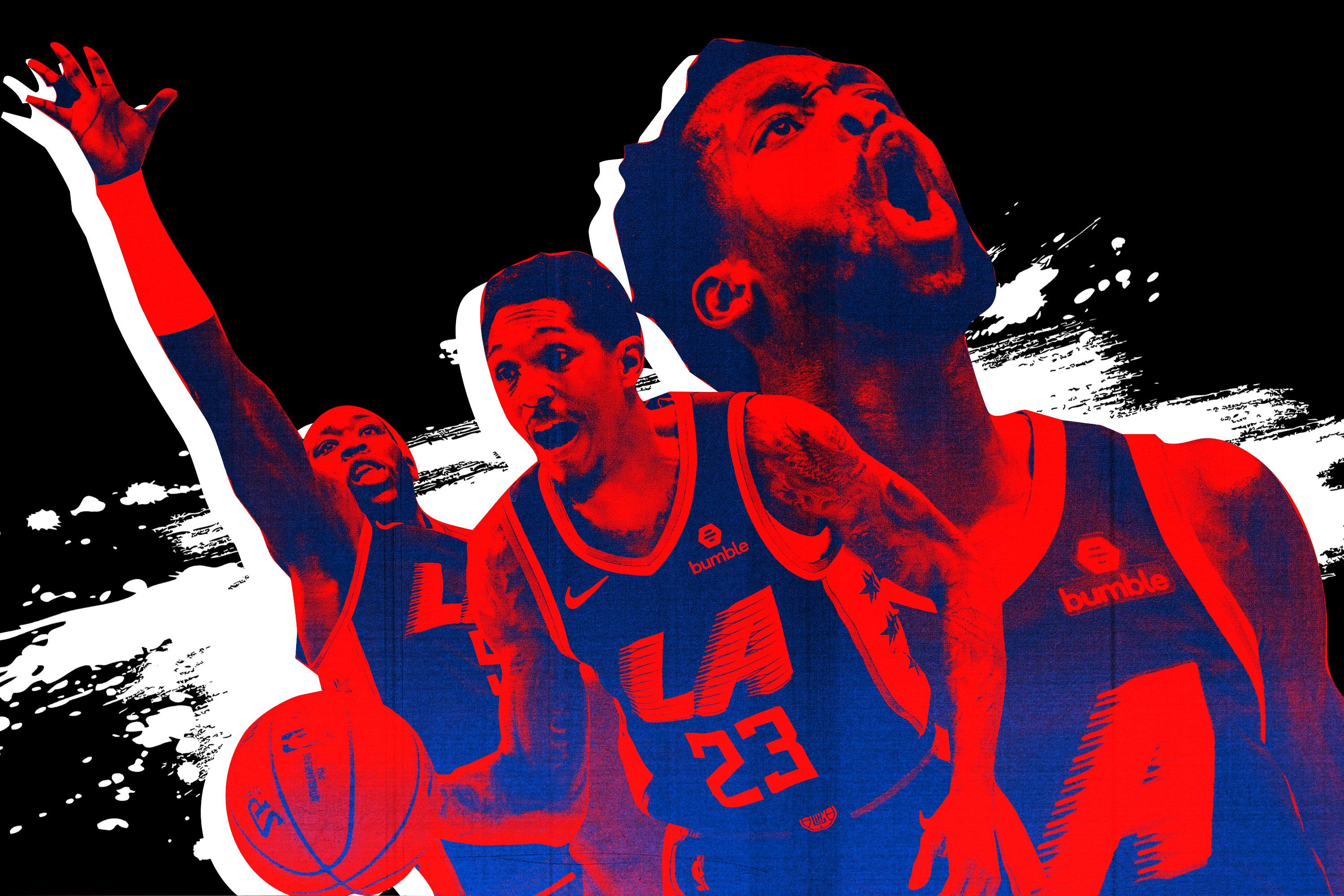
Lou Williams, who in Monday night’s 140-115 win over the Boston Celtics became the NBA’s all-time bench scoring leader with 11,154 points across 14 seasons, is a deceptive player, perhaps because his style offers no false pretense. Announcers, who thrive on reacting to drama, are often left stunned by just how perfunctory Lou’s scoring outbursts appear. He doesn’t possess a suite of theatrical dribbling maneuvers; he seldom adds English to any of his shots around the rim; once a fiendishly explosive leaper, he’s learned to channel all of his wrong-side-of-30 athleticism into a sudden first step that routinely freezes opponents despite his scouting report largely being the same for the past five years. If Williams has a signature move, it’s this: a full-court, longitudinal saunter, navigating around a high screen on the left side of the court, dragging a big man out into a no-man’s-land on the perimeter before taking flight, drifting left, and shooting, just as his defender exits his line of sight.
He is a blunt offensive instrument that, once airborne, adopts the characteristics of a kite. One of the most important objectives in basketball is to create space, and on an individual level, most players have opted to follow the Michael Jordan gold standard of modulating their in-air positioning on the y-axis, leaning back to establish separation. Williams creates space along the x-axis, seemingly gliding parallel to his primary defender in midair. When Williams’s defender jumps, he is suddenly in the domain of the scorer; Lou no longer has an obscene vertical leap, but his hangtime drifting laterally means that it’s his defender who is the one creating windows of time and space for Williams to get off a clean look. In essence, Williams outsources the hardest part of his job to his defender. It is one of the NBA’s great, understated wonders.
Teams invariably gravitate toward their best player, but what exactly does that mean when your best player is one of the greatest reserves to ever live? In a season full of pleasant surprises around the league, the Clippers, now the 6-seed out West, present a unique set of circumstances for their success. Bench scoring is a luxury that much of the league’s elite doesn’t bother with; the five teams at the very bottom in bench points per game this season—the Rockets, Warriors, Thunder, Bucks, and Sixers—are all contenders. The Clippers, on the other hand, average 53 bench points per night, nearly five points greater than the second-most-prolific reserve offense of the past 20 years—coincidentally Doc Rivers’s 1999-2000 “Heart and Hustle” Orlando Magic team that boasted Darrell Armstrong as its best player, a team that won Rivers a Coach of the Year award in his rookie season as a head coach.
Rivers is on the record saying that the Heart and Hustle Magic are one of his two favorite coaching experiences. “This [Clippers] team is similar, but this team is a little more talented,” Rivers said in January. In both cases, Rivers was given carte blanche. Without a domineering star presence, lineup patterns and configurations become less about managing ego and more about fostering compatibility all along the roster—something of a novel concept for a coach who has spent most of his career placating the likes of Kevin Garnett, Paul Pierce, Ray Allen, Rajon Rondo, Chris Paul, Blake Griffin, and DeAndre Jordan. In Lou Williams, Rivers has a player who has faced his own ego death six teams over—at that point, the concept of traditional team hierarchy warps into something far more psychedelic.
Since trading star Tobias Harris to the Sixers in a win-win deadline deal, the Clippers are full of players who would classify as the fourth- and fifth-best starter on a more traditionally constructed roster. Danilo Gallinari, having arguably the best overall season of his career, is the only player on the roster averaging more than 30 minutes per game, which is a testament to both the Clippers’ depth and Gallo’s newfound health—he is on pace to play more games this season than he has in any of the previous five. No one in the current rotation averages fewer than 18 minutes per game, either. Rivers has the freedom to mix and match lineups, though the makeup of his roster creates very obvious modern templates. At any given point in a game, the Clippers will have on the court a four-out offense, with either four on-ball playmakers (when Gallo is on the floor at power forward) or four premium floor spacers (when JaMychal Green is in at the 4) and either Ivica Zubac or Montrezl Harrell as the rim-running center. With that many players capable of making plays off quick reads in a floorplan stretched to its limits, the Clippers present obstacles to their opponents not via star power, but depth and competent strategy.
The Clippers are riding a five-game win streak, tied for their longest of the season; the first was part of an 11-2 stretch to close out the month of November, at a time when it appeared as though the team was one of the best in the West. They’re playing burdenless basketball right now, but the burden of proof will fall swiftly in the playoffs. The crucible of a best-of-seven series has a way of weeding out teams built on egalitarian dreams—just ask the 2014-15 Hawks, or Gallinari’s 2012-13 Nuggets. Williams, for all his gifts, is still a slight, 6-foot-1 guard who will essentially be as close to 35 as he is to 30 by the time the playoffs come around. The team is almost impossibly deep, but relies on a handful of young and inexperienced players: 20-year-old rookie Shai Gilgeous-Alexander, 21-year-old rookie Landry Shamet, and 21-year-old big man Ivica Zubac. Gilgeous-Alexander’s immediate translation in the NBA as a starting guard has been a revelation, but he might not yet have the strength to hold up in a physical seven-game series. Shamet’s seamless transition into the Clippers starting lineup as something of a JJ Redick doppelgänger—his on/off net rating in the 12 games since the deadline is astronomical—is equally impressive, but he is a defensive liability anywhere on the floor. And Zubac has ingratiated himself well in his 12 games as a Clipper, but he’ll face the same question every traditional center runs up against in the playoffs—can he defend in space?
And yet, it’s hard not to be optimistic about the Clippers, who have pulled off the elusive triple-whammy of developing young and inexpensive talent, becoming a legitimate playoff threat, and cultivating both culture and the cap space to add a true superstar (or two), all in the same season. Perhaps it all comes back to the most distinguishable facet of their identity. There are teams that pride themselves on their second unit, and then there’s the Clippers, who feel like one continuous, flowing entity that happens to be 12 deep. The Clippers, now roughly a season removed from the headaches of the Lob City era, have become a dream—for players, coaches, and the front office.
In 2014, when the Los Angeles Clippers promoted coach and then-senior vice president of basketball operations Doc Rivers to the role of franchise majordomo—empowering him with the final say both on and off the court—there was a distinct ethos the team was hoping to replicate. Rivers’s final two seasons as a player were as a part of the San Antonio Spurs operation, and it was Gregg Popovich, then the Spurs GM, who brought him in. Popovich would become a coaching rival only seasons later (and one of the greatest coaches in any American professional sports league, full stop), but what he implemented in San Antonio while Rivers was in the organization was the model Doc tried to follow in his new venture. Doc had long admired the way the Spurs crafted a teamwide sensibility and stuck to it for decades.
“Pop always used the line, ‘Over themselves.’ He wants guys ‘over themselves,’ guys who aren’t pouting when they’re on the bench. Guys, who when they come out, sprint out and are happy,” Rivers told ESPN in 2015. “They keep finding guys like that. They’ll tell you privately they’ve missed on a couple that could have fit even better but they thought he may not so they passed. They’d rather pass and get that right than take any risk.”
Rivers’s four-year coach-president experiment, of course, failed spectacularly. And the Clippers have taken risks along the way, with most of them coming in the past year. But there’s something to be said about the almost palpable synergy that comes when a coach and a roster seamlessly entwine. Doc has coached some great teams in the past, and he’s won a championship managing some of the biggest names in the sport. But he’s seldom seemed more positive than with this motley group of players, a collective that has brought Rivers all the way back to his beginnings. These Clippers aren’t the Heart and Hustle Magic, and there’s no point in affixing a cute nickname to a team so obviously in flux, but for once, it seems like things are going even better for the Clippers than the team could have hoped for.

